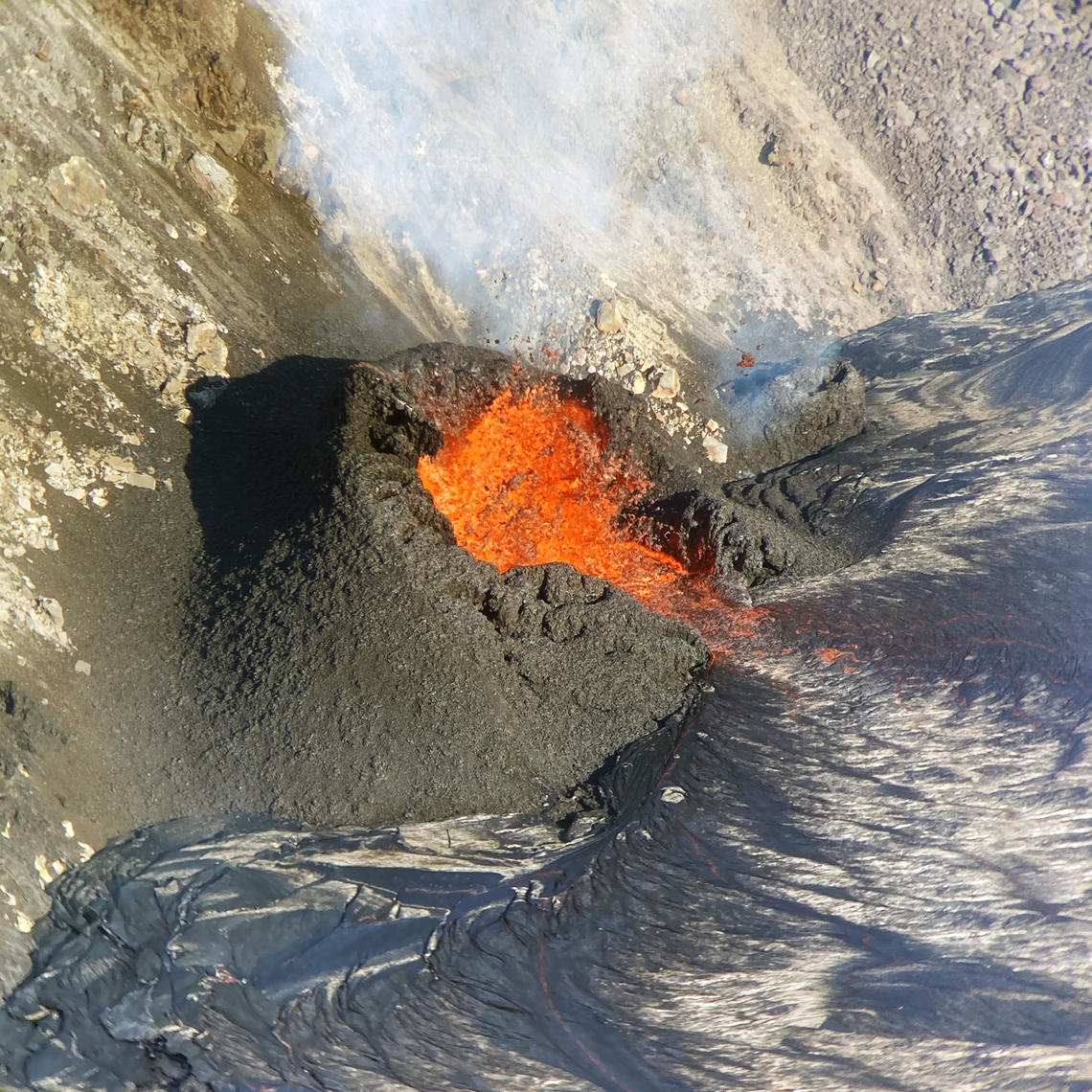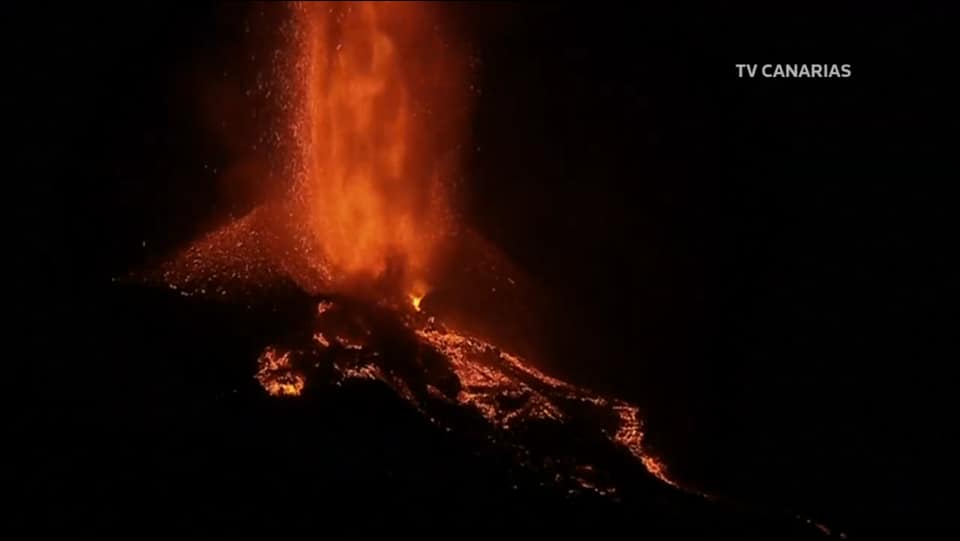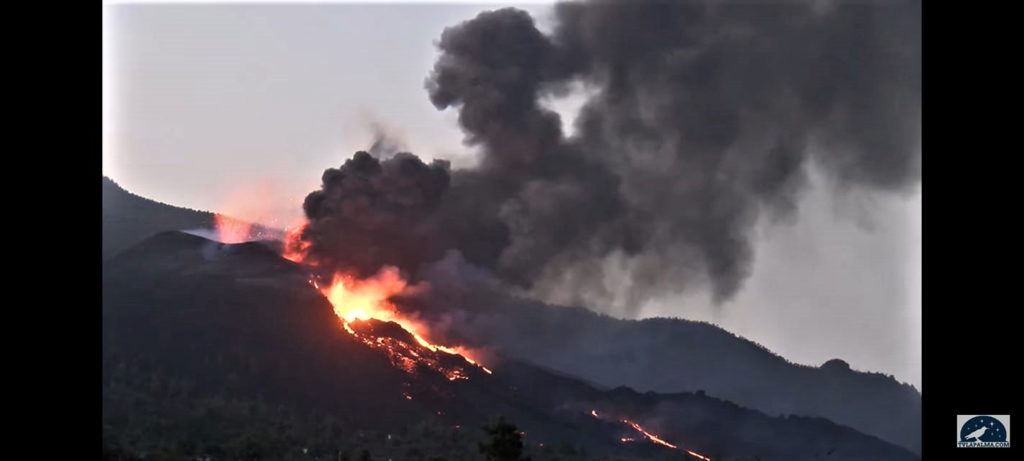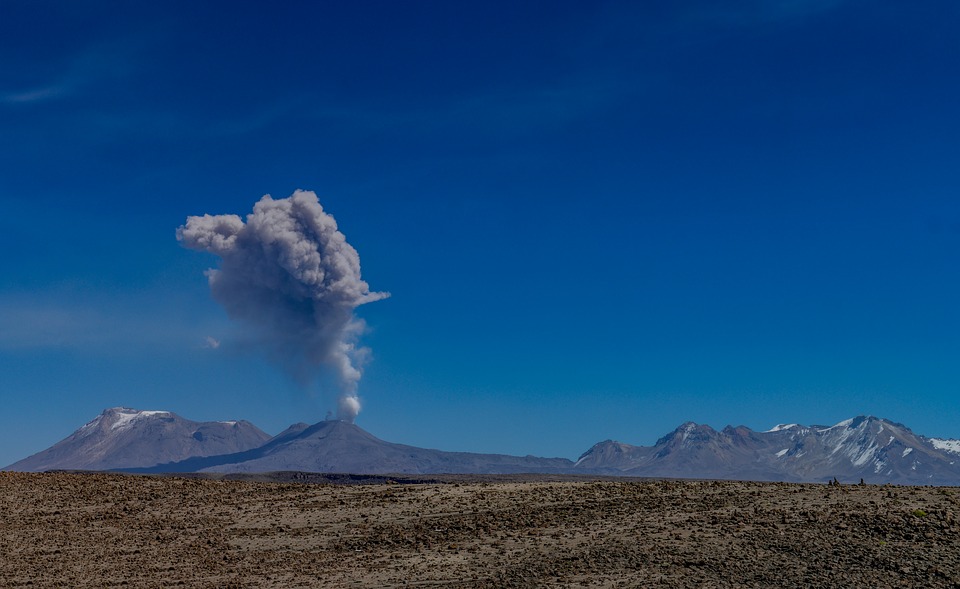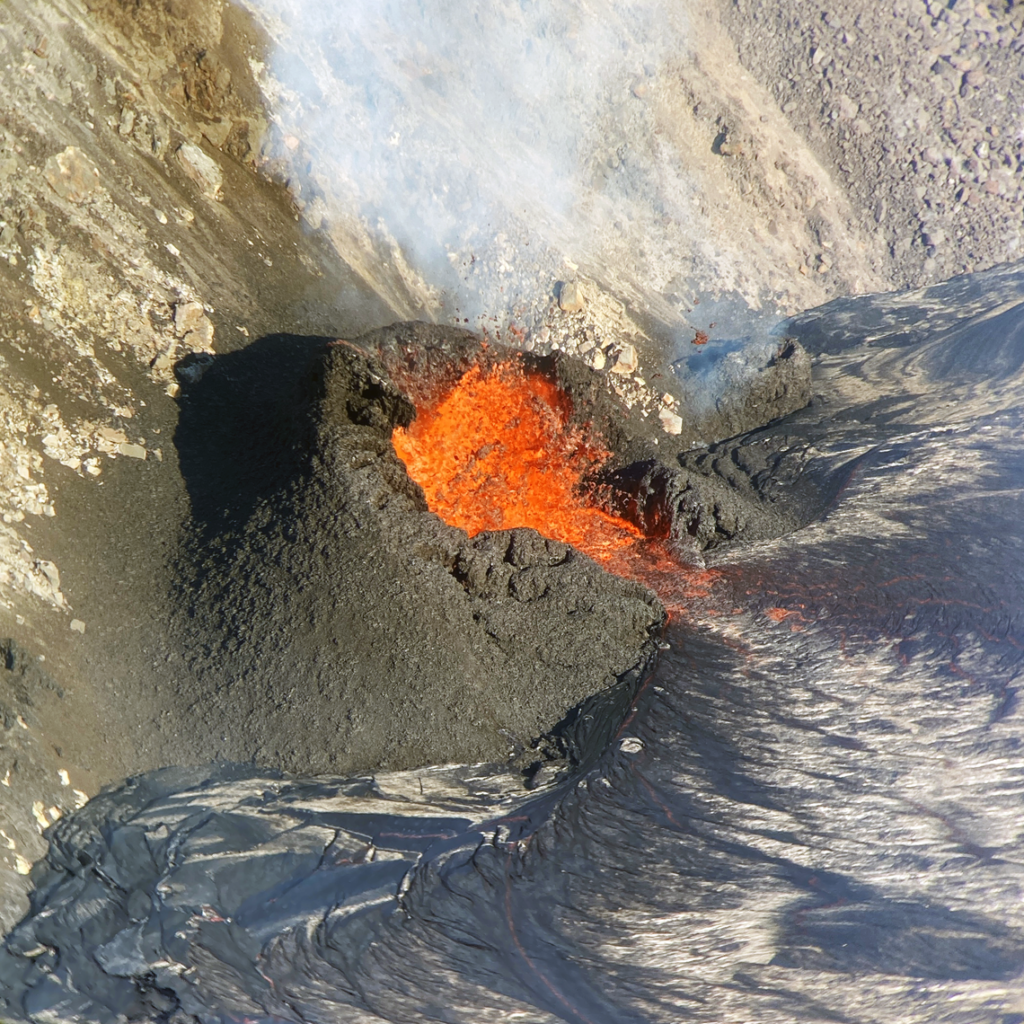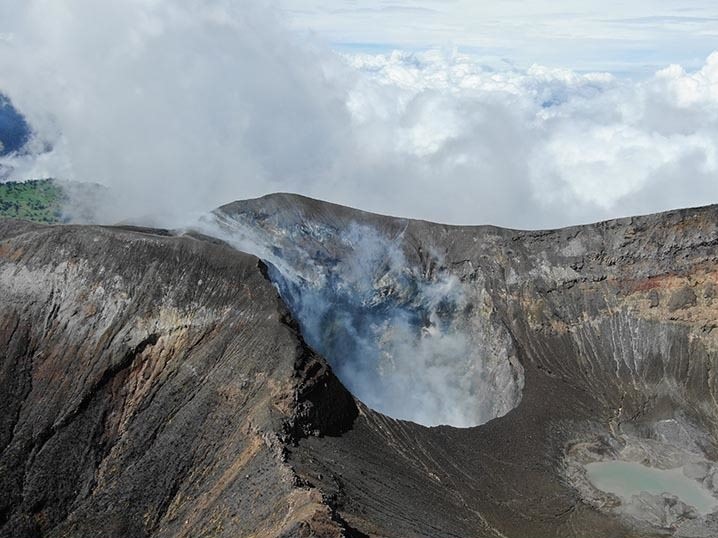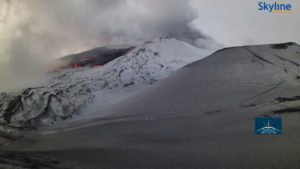October 05 , 2021.
Spain / La Palma , Cumbre Vieja :
Dozens of earthquakes have been recorded in the past 24 hours, the maximum of magnitude 3.7.
Maria José Blanco, director of the National Geographic Institute of the Canary Islands (IGN), after the Pevolca meeting: “The seismicity continues with the same pattern and maintaining a depth of around 10-15 kilometers. Earthquakes are recorded at depths greater than 20 km. In the past 24 hours, dozens of events with a maximum magnitude of 3.7 have been recorded with an intensity of 3-4. The noticeable increase in the number of earthquakes and their magnitude may indicate an increase in the likelihood that more deep earthquakes will occur and may result in small collapses in sloping areas.
Regarding the emission of sulfur dioxide in the volcanic plume, the values measured yesterday reached 16,000 tonnes per day, a value higher than the previous day. CO2 emissions throughout the Cumbre Vieja area amount to 1,748 tonnes per day. The low values are maintained in terms of air quality, except for occasional peaks in Los Llanos and El Paso, but of low intensity and far from the thresholds set by the regulations in force. Regarding particles smaller than 10 microns, only the daily threshold was exceeded again at the Los Llanos station ”.
04 October 2021 14:00 UTC, Eruptive activity continues on La Palma
Since the last declaration, 115 earthquakes have been located in the southern part of the island of La Palma, 12 of them felt by the population and 4 reach a maximum intensity III-IV in the epicentral zone. The largest earthquake, 3.7 (mbLg) occurred at 19:14 UTC yesterday afternoon.
As in the previous days, the depths of the hypocenters are between 10-15 km with the exception of 6 earthquakes at great depth (30-36 km) in the same epicentral area, where other seismic swarms had already been recorded in 2017 , 2018 and 2020.
The mean amplitude of the volcanic tremor continues in the same range of mean values compared to that observed since the start of the eruption, although it has presented different impulses during the last two days, coinciding with the times when the superficial activity has intensified.
The height of the column measured at 5:30 UTC is 4,500 m, a value similar to the previous days.
The island’s network of permanent GNSS stations shows stability in the deformations of stations close to eruptive centers.
Source : El Pais , Involcan .
Photos : TV Canarias , TV la Palma.com
Peru , Sabancaya :
Analysis period: September 27, 2021 to October 03, 2021, Arequipa, October 04, 2021.
Alert level: ORANGE
The Geophysical Institute of Peru (IGP) reports that the eruptive activity of the Sabancaya volcano remains at moderate levels, that is to say with the recording of an average of 30 daily explosions, with columns of ash and gas up to 3.5 km altitude above the summit of the volcano and their consequent dispersion. Therefore, for the following days, no significant change is expected in eruptive activity.
The IGP recorded and analyzed the occurrence of 989 earthquakes of volcanic origin, associated with the circulation of magmatic fluids within the Sabancaya volcano. An average of 30 explosions was recorded daily. During this period, Volcano-Tectonic (VT) earthquakes associated with rock fractures were located mainly in the North-East and East of Sabancaya and presented magnitudes between M2.0 and M3 , 5.
The monitoring of the deformation of the volcanic structure using GNSS techniques (processed with fast orbits) does not present any significant anomalies. However, in general, an inflation process was observed in the northern sector (around the Hualca Hualca volcano). The visual surveillance made it possible to identify columns of gas and ash up to 3.5 km altitude above the summit of the volcano, which were scattered towards the South, South-East, North, South-West and North-East of Sabancaya. Satellite recordings have identified the presence of 9 thermal anomalies (maximum value of 7 MW) associated with the presence of a lava body on the surface of the volcano’s crater.
RECOMMENDATIONS
• Keep the volcanic alert level in orange.
• Do not approach within a radius of 12 km from the crater.
Source : IGP.
Photo : Pixabay
Hawaii , Kilauea :
VOLCANO OBSERVATORY NOTICE FOR AVIATION (VONA)
Issued: October 05 , 20211005/0252Z)
Volcano: Kilauea (VNUM #332010)
Current Color Code: ORANGE
Previous Color Code: RED
Source: Hawaiian Volcano Observatory
Notice Number: 2021/H273
Volcano Location: N 19 deg 25 min W 155 deg 17 min
Area: Hawaii
Summit Elevation: 4091 ft (1247 m)
Volcanic Activity Summary:
Kīlauea volcano is erupting. At approximately 3:21 p.m. HST on September 29, 2021, an eruption began within Halemaʻumaʻu crater, within Kīlauea’s summit caldera in Hawai‘i Volcanoes National Park. The USGS Hawaiian Volcano Observatory (HVO) elevated Kīlauea’s volcano alert level to WARNING and its aviation color code to RED to assess the intensity of eruptive activity and identify associated hazards.
This zoomed-in view of the erupting western fissure in Halema‘uma‘u shows lava fountaining activity on the morning of October 4, 2021. The fountains have built a C-shaped spatter rampart around their source, which is now submerged in the rising lava lake. Using a laser rangefinder, HVO field crews measured the spatter rampart to be standing 20 m (66 ft) above the surrounding lava lake surface.
Vigorous fountaining—with bursts up to 50–60 meters (164–197 ft)—produced significant amounts of pumice, Peleʻs hair, and fragments of volcanic glass that were deposited in areas downwind along the rim and beyond Halemaʻumaʻu crater. Over the past several days, a thick layer (approximately 27 meters or 89 ft) of molten lava has accumulated as a lava lake at the base of the crater, partially drowning the vents resulting in subdued fountaining. During the same time, the amount of sulfur dioxide (SO2) emitted has dropped from 85,000 tons per day (one metric ton equals 2,200 pounds) to 12,000 tons a day. Although the amount of gas and volcanic particle production has decreased since the eruption onset, they both remain significant local hazards within the plume. Concentrations of SO2 at the vents remain high (likely over 100 parts per million or ppm) and significantly elevated (5-10 ppm) at stations a few kilometers (a couple of miles) southwest of Halemaʻumaʻu.
This photo, captured on the morning of October 4, 2021, provides a zoomed-in view of the eastern edge of the main island in the Halema‘uma‘u lava lake. In the earliest days of the ongoing Kīlauea eruption, this was the site of an energetic eruptive vent that showered the island with spatter and tephra. Activity had waned substantially, but not completely: volcanic gases continue to be emitted (center left), and spreading textures on the surface of the lava lake (center) indicate continued slow effusion of lava at this site.
The eruption is currently confined to Halemaʻumaʻu crater, within Hawai‘i Volcanoes National Park. HVO does not see any indication of activity migrating elsewhere on Kīlauea volcano and expects the eruption to remain confined to the summit region.
HVO is lowering Kīlauea’s volcano alert level to WATCH and its aviation color code to ORANGE, reflecting the less-hazardous nature of the ongoing eruption.
Remarks:
Prognosis:
It is unclear how long the current eruption will continue. Kīlauea summit eruptions over the past 200 years have lasted from less than a day to more than a decade. This ongoing eruption is similar to the most recent Kīlauea eruption, which was also confined to Halemaʻumaʻu crater and generated a lava lake; the most recent eruption lasted approximately five months, from December 2020 to May 2021.
Source : HVO.
Photos : USGS / M. Zoeller.
Indonesia , Ili Lewotolok :
VOLCANO OBSERVATORY NOTICE FOR AVIATION – VONA
Issued : October 05 , 2021
Volcano : Ili Lewotolok (264230)
Current Aviation Colour Code : ORANGE
Previous Aviation Colour Code : orange
Source : Ili Lewotolok Volcano Observatory
Notice Number : 2021LEW39
Volcano Location : S 08 deg 16 min 19 sec E 123 deg 30 min 18 sec
Area : East Nusa Tenggara, Indonesia
Summit Elevation : 4554 FT (1423 M)
Volcanic Activity Summary :
Eruption with volcanic ash cloud at 00h01 UTC (08h01 local). Eruption and ash emission is not continuing.
Volcanic Cloud Height :
Best estimate of ash-cloud top is around 7114 FT (2223 M) above sea level, may be higher than what can be observed clearly. Source of height data: ground observer.
Other Volcanic Cloud Information :
Ash-cloud moving to Northwest
Remarks :
Seismic activity is characterized by continuous volcanic tectonic Earthquake.
Activity Level at Level III (Siaga) since November 29, 2020 at 1:00 p.m. WITA.
The volcano was clearly visible until it was covered in fog. The smoke from the crater is white / gray with low intensity, medium to thick, about 100-700 meters above the summit. The weather is sunny to cloudy, the winds are light to moderate from the east, southeast, southwest and west. The air temperature is around 25.8-32 ° C.
The eruption was accompanied by rumblings and a low to loud explosion sound. We note an observable ejection of incandescent material towards the South-East up to about 200 m above the summit.
According to the seismographs of October 4, 2021, it was recorded:
74 eruption / explosion earthquakes.
101 earthquakes of emissions
7 times harmonic tremors
26 Non-harmonic tremors
2 distant tectonic earthquakes
Continuous tremor of amplitude 0.5 mm, dominant value 0.5 mm
Sources : Magma Indonésie , PVMBG.
Photo : Rizal M
Costa Rica , Turrialba / Poas / Rincon de la Vieja :
Daily report of the state of volcanoes. Updated at: 10:18:00.
Turrialba volcano :
No eruption is reported.
Seismic activity is similar, compared to yesterday.
At the time of this report, the winds are blowing from the west.
Degassing is observed in the active crater. Frequent high and low frequency earthquakes are detected. In recent days, geodetic observations show no significant deformation. Gas ratios are within the range of the past few days. The concentration of SO2 does not show significant changes.
Poas volcano:
No eruption is reported.
Seismic activity is similar, compared to yesterday.
At the time of this report, the winds are blowing from the southwest.
Frequent convection pulses continue to be observed in the volcano’s mouths, due to underwater fumarolic activity. Short tremor signals continue to be detected at seismic stations. Geodesic observations do not show any significant deformation of the volcano. The H2S / SO2 gas ratios, as well as the SO2 concentration, remain relatively stable. Today, CO2 / SO2 data is not available.
Rincón de la Vieja volcano:

No eruption is reported.
Seismic activity is similar, compared to yesterday.
Wind direction is unknown at this time.
When weather conditions allow, a slight degassing is observed in the active crater. No tremor is detected. Geodetic observations show stability in the last days.
Source : Ovsicori.
Photos : G. Avard / Ovsicori , ovsicori, Raul Mora / RSN / UCR .

